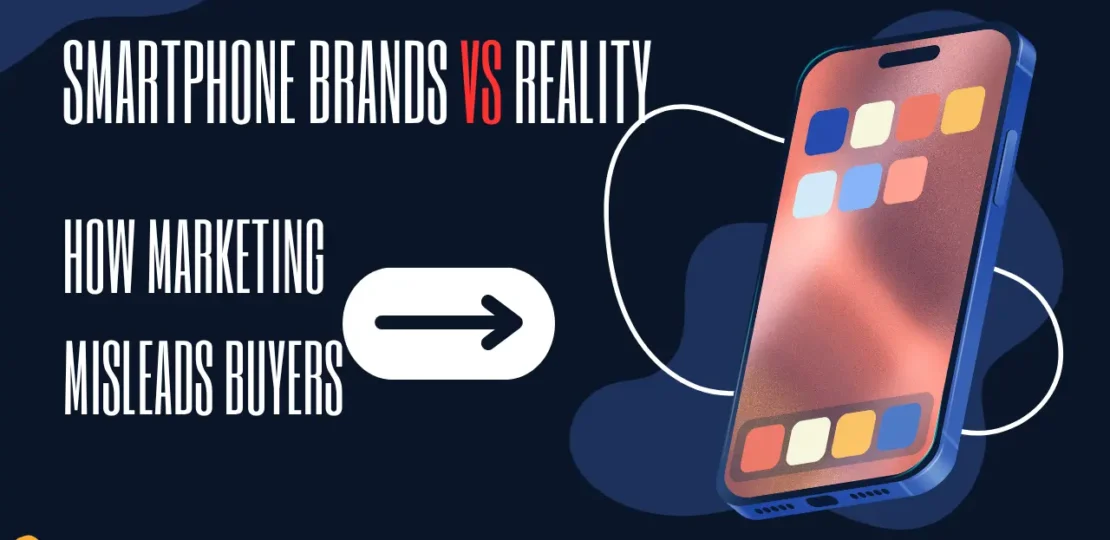Smartphone Brands vs. Reality: How Marketing Misleads Buyers
October 11, 2025 | by Wellness World

Keywords used: smartphone marketing tricks, consumer awareness, smartphone buying guide, fake camera megapixels, AI performance in phones, mobile brand comparison, smartphone consumer guide India, smartphone buying tips
Introduction: The Illusion Behind Every Flashy Ad
Every year, smartphone brands flood the market with new launches — each promising to be “the fastest,” “the smartest,” or “the best camera phone ever.”
But behind the glossy advertisements and influencer reviews lies a different reality.
From exaggerated megapixels to hyped-up “AI” features, many smartphone marketing tactics are designed to confuse or impress consumers — not to inform them.
In this post, we’ll break down the truth behind smartphone marketing, explain the common traps, and help you make smarter choices the next time you’re ready to upgrade.
1. The Megapixel Myth: Bigger Numbers Don’t Mean Better Photos
One of the oldest and most common tricks in smartphone marketing is megapixel hype.
You’ve seen it — “200MP Ultra AI Camera” flashing on the box. But here’s the truth:
- More megapixels ≠ better quality.
A camera’s quality depends on the sensor size, lens, and image processing, not just megapixels. - Tiny sensors + more pixels = noise.
When brands cram too many pixels into a small sensor, images may look detailed but lose clarity in low light. - Software tricks create fake results.
Many budget phones use software interpolation — artificially increasing resolution — to claim higher megapixel counts.
Real Tip:
If you love photography, look for sensor size (e.g., 1/1.5-inch), aperture (f/1.8 or lower), and OIS (Optical Image Stabilization) instead of just megapixels.
Example:
A 12MP iPhone camera often outperforms a 108MP budget phone because Apple’s image processing and sensor size are superior.
2. AI Buzzwords: The Invisible Marketing Weapon
AI (Artificial Intelligence) has become the “magic word” in smartphone marketing.
You’ll find features like:
- AI-powered portrait mode
- AI scene detection
- AI performance boost
- AI battery optimization
But what does it really mean?
Reality Check:
- Most of these “AI” features are basic algorithms, not real artificial intelligence.
- AI scene detection simply recognizes whether you’re shooting a sky or a face and adjusts color tones — something even old smartphones did.
- “AI performance” is often just CPU optimization — the phone limits background apps to save battery or improve speed temporarily.
Real Tip:
Don’t fall for the “AI” label. Read real-world reviews and camera comparisons instead of trusting brand claims.
3. Fast Charging: The Numbers Game
Every new smartphone seems to boast about charging speed — 33W, 65W, 120W, and now even 240W “hyper charging.”
It sounds revolutionary… but let’s slow down a bit.
What’s Really Happening:
- Many brands only achieve those speeds under ideal lab conditions using special chargers.
- Charging speed often slows down after 50–60% to protect the battery.
- Over time, extreme fast charging can degrade battery health if used daily.
Real Tip:
Focus on battery capacity (mAh), power efficiency (processor type), and real-world endurance tests, not just “W” numbers.
A well-optimized phone with 30W charging can outlast a 100W phone with poor battery management.
4. The Benchmark Trap: When Numbers Fool You
Tech reviewers often show benchmark scores (AnTuTu, Geekbench, etc.) — and brands love to highlight them.
While benchmarks measure raw performance, they don’t tell the full story.
Here’s Why:
- Some brands optimize their software to cheat during benchmark tests to get higher scores.
- Benchmarks don’t measure heat management, battery life, or software stability — all crucial for real-world usage.
- A phone with high benchmarks can still lag or overheat after a few weeks.
Real Tip:
Look for real performance reviews (like app load times, gaming tests, and multitasking behavior). Benchmarks are just one piece of the puzzle.
5. Display Tricks: When “AMOLED” Doesn’t Tell the Whole Story
Every company promotes “AMOLED,” “Super AMOLED,” “120Hz refresh rate,” and “HDR10+ support.”
But these terms can also be misleading if you don’t know what to look for.
The Catch:
- Some phones advertise 120Hz refresh rate, but they don’t maintain it consistently — they drop to 60Hz to save power.
- “AMOLED” quality depends on the panel supplier — Samsung’s AMOLED panels outperform many cheaper ones.
- Many “HDR10” phones can technically decode HDR but lack true brightness and contrast to display it properly.
Real Tip:
Check brightness levels (nits), color accuracy (DCI-P3 coverage), and real HDR support. A balanced display is better than one overloaded with buzzwords.
6. The “Performance King” Myth: How Brands Play with Processors
Brands often market their phones with phrases like:
- “Flagship processor for ultimate performance!”
- “Gaming beast with Snapdragon XYZ chip!”
But that’s not the full picture.
Reality:
- Two phones with the same processor can perform very differently based on cooling and optimization.
- Some phones throttle performance under heat, while others manage it better with vapor cooling.
- The “gaming” tag doesn’t guarantee smooth gameplay if the software isn’t tuned well.
Real Tip:
Look beyond the chipset. Check RAM type (LPDDR5 > LPDDR4X), storage speed (UFS 3.1 or 4.0), and sustained performance reviews.
7. Fake “5G Ready” Phones: The Future Trap
In India and many other countries, the term “5G Ready” has been heavily used since 2022.
But not all “5G phones” are truly ready for the future.
Here’s How They Mislead You:
- Some phones support only limited 5G bands, making them incompatible in certain regions.
- Budget phones often skip NSA/SA (non-standalone/standalone) support.
- A phone might connect to 5G but still lack efficiency or signal stability.
Real Tip:
Before buying, check if the phone supports India’s key 5G bands (like n77, n78, n28) and whether it supports both NSA and SA.
8. Camera Tricks: When Software Fakes Reality
Apart from megapixels, brands also manipulate camera output through software.
Common Tricks:
- Beauty Mode: Smoothens your skin unnaturally even when “off.”
- Over-saturation: Boosts colors to look more appealing on-screen but unnatural in reality.
- AI HDR: Blends multiple exposures automatically, sometimes causing halo or ghost effects.
Real Tip:
Always check sample photos and videos from independent reviewers, not brand promos.
Also, see how the camera performs in low light and video stabilization tests, which reveal the real capability.
9. Software Updates: The Silent Deal Breaker
Some brands promise “3 years of Android updates” — but few truly deliver.
After the initial marketing phase, many mid-range phones are forgotten by the brand.
What Happens Then:
- You stop getting security patches, leaving your phone vulnerable.
- App compatibility issues grow over time.
- Performance degrades because new OS versions aren’t optimized for your model.
Real Tip:
Choose brands known for consistent software support (Google Pixel, Samsung, OnePlus).
Always check past update history before buying — not just the promise.
10. Influencer & Review Manipulation: The New Marketing Weapon
Many YouTube and Instagram reviews today are sponsored or partially influenced by brands.
While some creators disclose it, others don’t — leading consumers to trust biased opinions.
Spot the Signs:
- Reviews with only positive points and no real negatives.
- Titles like “Best phone under ₹20,000 – Must Buy!”
- Same language used across multiple reviewers (likely from the brand’s press kit).
Real Tip:
Look for unsponsored, long-term reviews**, or community feedback (Reddit, forums, real user comments).
Don’t rely solely on influencer unboxings.
11. The Truth About “Made for India” Phones
Some brands promote “Made for India” as a slogan to attract local buyers.
But often, this is just a marketing tag — not a sign of better quality or customization.
- The devices are assembled in India, but components come from China or Vietnam.
- The software may include bloatware or ads targeting Indian consumers.
- After-sales service quality still depends on global brand policy — not “Made in India” status.
Real Tip:
Support local assembly, but buy based on product quality and service record, not slogans.
12. What You Should Really Look For Before Buying a Smartphone
To become a smart, informed consumer, here’s a simple checklist:
✅ Performance: Processor + RAM + Storage type
✅ Camera: Sensor size, lens quality, image processing
✅ Battery: Capacity + efficiency + real endurance
✅ Display: Brightness (nits) + color accuracy + refresh rate stability
✅ Software: Update track record + clean UI + privacy
✅ Brand Reputation: After-sales service, reliability
✅ Reviews: Independent long-term usage opinions
Conclusion: Be a Smart Buyer, Not a Marketing Target
Smartphone companies spend crores of rupees every year to influence your decision.
But as a consumer, your awareness is your power.
Don’t buy into flashy numbers, big megapixels, or overhyped “AI” claims.
Instead, focus on real performance, build quality, and user experience.
Every smartphone may look “smart” in an advertisement — but only an informed buyer can see through the illusion.
Final Words:
Next time you’re about to click “Buy Now,” remember —
your decision shapes the market.
Brands will only stop misleading consumers when people start asking the right questions.
Stay smart. Stay aware. 📱💡
RELATED POSTS
View all


